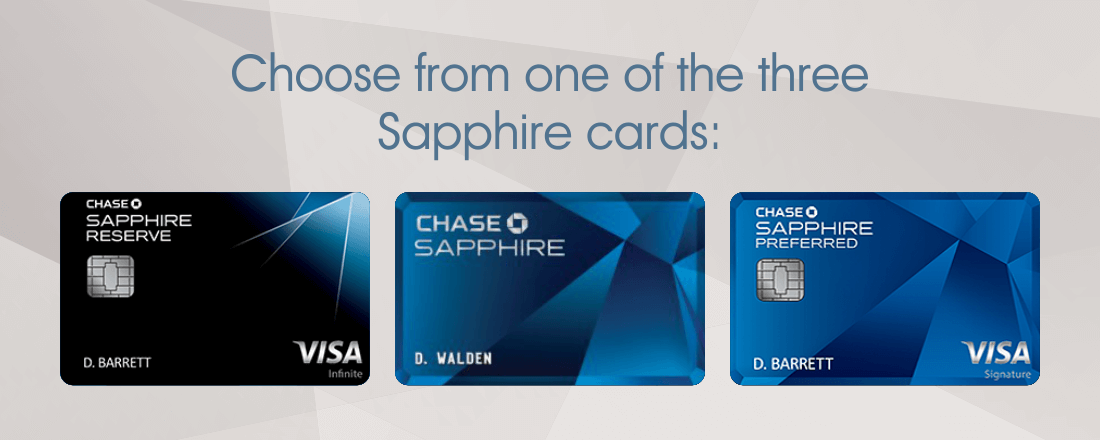
Chase continues to make it more difficult to get approved for new credit cards and earns large sums of points with sign up bonuses. By now, many are familiar with the 5/24 rule, in which Chase will automatically reject applications for most of their cards if you have opened five or more new credit card accounts with any bank within the last 24 months.
Now, Chase has come out with a new rule, targeted at the Sapphire family of cards. There are three cards in the Sapphire family: the no annual fee Sapphire card, Sapphire Preferred, and Sapphire Reserve. Here are the new rules per a memo sent to Chase bankers:
- Going forward, a customer may no longer have more than one Sapphire-branded credit card. For example, if a customer has a Sapphire Preferred card, they are no longer eligible for a Sapphire Reserve card.
- While this change impacts all new and existing customers (including CPC clients), there is no impact to existing customers who presently have more than one Sapphire product. These customers continue to retain their Sapphire products as usual.
- If existing Sapphire customers wish to upgrade or downgrade their product, they made so if eligible. However, no bonus points will be available with this upgrade or downgrade. The customer may call the number on the back of their card or you may contact Banker Support with customers who are in the brand or already on the phone.
- If an account is closed, a customer will not be eligible for any Sapphire-branded credit card if they have earned a cardmember bonus on a Sapphire-branded product within the last 24 months.

In short, you will not be approved for a new Sapphire card if you have any of the three versions open. Those who have multiple Sapphire cards currently can keep them. Product changes between versions will still be allowed. You can only get one sign up bonus per 24 months for the entire Sapphire family.
How Does this Impact Sign-Up Bonus Strategy?
These new rules impact strategies for applying for Chase cards in multiple ways. In the past, for those who were under 5/24, a possible strategy was to double up on sign-up bonuses by applying for both the Sapphire Preferred and the Sapphire Reserve before going over 5/24. This way, you could get the bonus for both of these cards before turning your focus to cards from other banks. Now, this is no longer possible.
If you are under 5/24 and have other Chase cards subject to 5/24 that interest you, you could pair an application for a Sapphire card with an application for a non-Sapphire Chase card to still get multiple sign up bonuses.
The sign-up bonuses for the Sapphire Preferred and Sapphire Reserve are both currently 50K points. Therefore, if the sign-up bonus is your primary consideration when determining which card to get, it doesn’t matter which card you choose. By the time you are eligible for another sign-up bonus on a Sapphire card you will be able to choose any version of the Sapphire cards.
Which Version of Sapphire is best to keep Long-Term?
For those that are not grandfathered into having multiple Sapphire cards, the new rules make it so that you will only be able to hold one Sapphire card at a time. In the analysis below, we will weigh the pros and cons of each and help you determine which version warrants a place in your wallet.
- No-Annual Fee Sapphire Card: This card has a very sparse list of benefits and is only good for people who find the benefits of the other two versions duplicative with other cards. This card earns 2x points on dining (but not travel), carries no annual fee, and lacks the ability to transfer points to partners. However, it could be a good choice for people who hold one of Chase’s premium business cards and therefore already have the ability to transfer points to partners (Ink Plus, Ink Bold, or Ink Preferred). Since product changes are allowed between versions of Sapphire cards, you can keep your account open without paying an annual fee using this card, and product change to the Preferred or Reserve card later if you decide the benefits are worth the fee.
- Sapphire Preferred Card: The Sapphire Preferred card carries a $95 annual fee but has some important additional benefits relative to the no annual fee version. The 2x point earnings extends to travel as well as dining. You get 25% more value for points when doing direct redemptions through Chase’s online travel portal (1.25 cents per point versus one cent per point for the no annual fee card). Most importantly, this card offers the ability to transfer points to partners. This feature is critical if you want to maximize the value of your Ultimate Rewards. This opens up the ability to get outsized value by finding sweet spots in airline and hotel award charts. If you don’t have one of the premium business cards and don’t want to pay the $450 annual fee carried by the Sapphire Reserve card, then the Sapphire Preferred card is likely the right choice for you.
- Sapphire Reserve Card: The Sapphire Reserve card is Chase’s premium
travel rewards card. It carries a hefty $450 annual fee, but also offers the most comprehensive set of benefits. Much of the annual fee can be offset with an annual $300 travel credit. If you can take full advantage of this benefit, then the remaining annual fee is $150 or $55 more than the Sapphire Preferred card. In exchange for the extra $55 you get a variety of additional beneifts: - Access to airport lounges with a Priority Pass Select membership
- Higher point earning rates (3x on travel and dining)
- TSA Precheck or Global Entry application fee credit
- Higher point value for direct redemptions (1.5 cents per point)
If you feel that these additional benefits justify the higher annual fee, then the Sapphire Reserve card may be the best Sapphire card for you to hold long-term.

